- Location and arrival
- Unique Nature Habitat
- The Neustaedter Moor
- The Goldenstedter Moor
- Crane photography in the Rehdener Geestmoor
- Plant world in the bog
- Insect diversity of bogs
- Mammals in the bog
- Winter in the bog
- The equipment
- Conclusion
- Download maps Diepholzer Moor
The Diepholz Moor area is mostly in Lower Saxony and is located in the tri-city area of Bremen, Osnabrück and Hanover. The total area is approximately
118.000 hectares and of this, around 24.000 hectares are spread across 15 peat bogs.
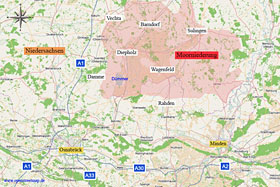
For better orientation, I have included an overview map on the left (for more details, please click on the map on the left). The directions, of
course, depend on which of the 15 bogs you would like to visit. Since I do not know all of the bogs, I will limit my report to a few bogs that I know.
Generally, almost all of the bogs are easily accessible by car. On the other hand, the accessibility of most bogs by public transportation is very limited and it is best
to explore the area with a bicycle. If you would like to visit the Diepholz Moor Lowlands by car from the north or south, the best connection will be via the A1 highway.
(back to the top)

The Diepholz Moor Lowlands consists of open raised bogs, heathlands, and wetlands and is therefore an important area for many rare breeding birds
and certain plants that require this vegetation of raised bogs. The characteristic feature of this barren, flat area is the mineral-poor and wet habitat, which results in
a unique flora and fauna. Some of the bogs have been re-flooded and the nature reserve, especially in the autumn, has gained great importance for crane roosting.
In many bogs,
moorland sheeps
are used for the maintenance of the landscape, which are excellently adapted to the habitat of the bog landscapes.
(back to the top)

The Neustädter bog, which covers an area of 2200 hectares, belongs to the municipality of Wagenfeld and can be reached from the south via the village
of Ströhen. Please see (
directions)
for more information.
There are two parking lots on the way to the moor, with the southern parking option passing by a BUND station and the northern parking lot located near the observation tower.
Although visitors are not allowed to enter the moor itself, there are many paths that lead into the moor, and a nature trail has been established that allows visitors to venture
into the heart of the moor. Throughout the year, the Neustädter bog offers plenty of photo opportunities. In July, for example, visitors can discover the sundew, a carnivorous
plant. The cross-leaved heath and the cotton grass, which begins to bloom in March, are also worthwhile photo subjects. In the fall, a large number of cranes can be observed as they fly
to their roost in the restored wetlands. Although there are many smaller birds to observe in the moor, such as shrikes or skylarks but thw photographic opportunities are
limited. The flight distances are very large and visitors are not allowed to up a hide. In addition to the plant life, however, the moor landscape presents itself in a different
light in every season.
(back to the top)
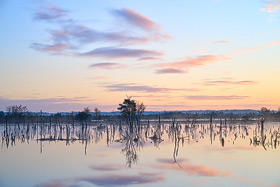
The Goldenstedter Moor is also known as the "Great Moor near Barnstorf". The moor is located in the tri-city area of the towns of Vechta, Barnstorf, and
the northern town of Goldenstedt. From the L881 state road, also known as Vechtaer Straße, visitors can reach the moor by following the Arkeburger Straße south for 5 km
(
see directions).
In addition to parking options, the moor features an
information center
and a
nature trail.
In addition, moor trips with the moor train are offered between March and October. Personally, the Goldenstedter Moor is one of my favorite moors in the Diepholz Moor region and
is particularly suitable for landscape photography. Many moors, such as the Goldenstedter Moor, were drained long ago to make them arable. However, through restoration efforts
starting in 1984, the moor has regained its original appearance. For me, the photographic appeal of this moor lies in the combination of peat and water areas. The moor is
protected, so visitors are only allowed to explore it on designated paths. During the time of the crane migration in the fall, some paths are additionally closed.
(back to the top)
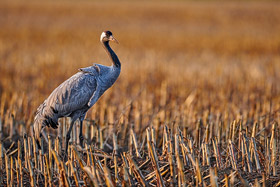
The Rehdener Geestmoor is located between Diepholz and Wagenfeld, and the best way to reach it is along the B239 highway
(
see directions).
Running straight through the moor is the moor dike, which is also accessible by car. The approximately 1800 hectare moor is under nature protection and was restored in the 1990s.
In the south of the moor dike, there is a three-story
observation tower
with a parking lot.
From there, you have a beautiful overview of the entire moor. This tower is also a gathering point for many ornithologists when the crane migration begins in the fall. From the
tower, you can observe the arrival of thousands of cranes at their largest sleeping place in the entire Diepholz Moor. However, I do not recommend photographing from the tower, as on
the one hand, the distances to the cranes are very far, and on the other hand, the many visitors on the tower make photography difficult. If you set up your lens on a tripod, it
quickly becomes clear why this is the case, as the wooden floor transmits every movement of the visitors to the tripod. I prefer to find a place away from the many visitors. However,
I cannot recommend an optimal location, as this also depends on the direction from which the cranes are flying, which changes practically daily.
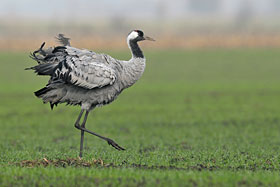
The best month with the largest number of cranes in the Rehdener Geestmoor is November. Unfortunately, November is also usually the month with the gloomiest light, but that can also
have a special appeal in crane photography. During the day, the cranes can be found on the harvested fields around the moor. Success can be achieved by driving down the side streets in
the area of Düversbrucher Straße. However, even when photographing from a car, the cranes' flight distances are still quite large. If you want to get closer to the cranes, you should
find a spot at the edge of the moor and obtain permission from the responsible farmer to set up a camouflage tent.
(back to the top)
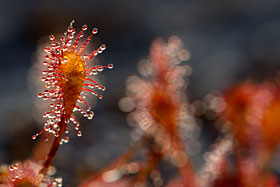
The moor is extremely nutrient-poor, so only a few plants have a chance to thrive on this soil. A typical moor plant is the sundew (drosera). This carnivorous plant does
not obtain its nutrients from the barren soil but feeds on the insects that have carelessly landed on the plant. The sundew is only a few centimeters high and not easy to spot and also not
easy to photograph. Often there is no other option but to place the camera directly on the ground to take pictures of the plant at eye level. The depth of field is usually extremely low, as you
are almost always working on a scale of 1:1. As the plant is an endangered species, extreme caution must be taken when photographing it, so as not to damage the environment or the plant itself.

It is much easier to photograph cotton grass than the sundew. Cotton grass is quite common in moors, and the best time to see it in full bloom in the Diepholz Moor area is mid to late June
when the "cotton balls" are on full bloom. In my opinion, backlit shots have a special charm with this plant. However, if you want to take a sharp photo without motion blur, you should
choose a relatively calm day. Other plants that are also common in the moor due to their ability to thrive in nutrient-poor soil include heather, cross-leaved heath, purple moor grass, peat moss,
cranberry, and of course, birch.
(back to the top)

From spring to autumn, the moors are populated by countless small and larger insects. While mosquitoes can be very annoying in midsummer, especially dragonflies, some
butterflies, or even spiders come to the fore as subjects. To avoid the stinging pests, which are primarily encountered between June and August, the early morning hours are a good time to
explore. In the early morning, insects are often in a state of cold rigor, especially after a cold night, which has the advantage that one can approach the insects calmly, and beautiful
light plays can result when the insects are covered in morning dew. However, a tour in the evening hours is also worthwhile because it is easier to approach the insects as many have already
found a place to sleep and are not as active. In the evening hours, I recommend having mosquito spray on hand during the summer months.
(back to the top)

Roe deer feel very comfortable in the moors and the adjoining meadows and are therefore encountered more frequently, especially in the early morning and evening hours.
Hares also like to stay in the safe habitat of the moors and are not an uncommon sight. Only the fox finds the moors too wet and usually looks for a different habitat.
(zurück zum Anfang)
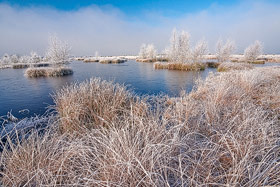
A visit to the moor is worthwhile at any time of the year. Although I especially appreciate the autumn time in the moor, the winters with the ice sheets that stretch over
the waters or the frozen hoarfrost that covers the reeds are equally a highlight, and therefore, the winter time in the moor is part of my annual must-see list. Unfortunately, snow has become
very rare in the north around Diepholz in recent years, so we were lucky in February 2021 and were blessed with more than enough snow. Therefore, in February 2021, I was able to experience a
moor landscape that was completely covered with snow.
(back to the top)
There a a lot of subjects in the Diepholz Moor Nature Reserve, which means that different lenses can be used. In landscape photography, in addition to wide-angle lenses, I also
like to use medium-range telephoto lenses (70-150mm full-frame). However, a macro lens is very useful at many times of the year. There are not only insects
to photograph, there are also many other details to capture. If you want to photograph cranes, very long focal lengths (500-600mm) are useful. Additionally, a tripod is obligatory
because the most beautiful moods are captured in the early morning hours or just before the sunset and then you have usually very low light.
My conclusion is very brief and it is that the Diepholz Moor Nature Reserve is always worth a visit You can visit the moor at any time of the year. However, my favorites are autumn and spring,
as the nature changes most rapidly during these seasons and is therefore the most exciting seasons. To capture a very special lighting mood, in addition to good preparation, you need a little bit of
luck. The closeness to the moors allows me to increase my chances of capturing a spectacular lighting mood because it is easy to visit the moors for me.
(back to the top)
You can download maps of the Diepholz Moor Nature Reserve here. To view and print them, you will need a PDF reader. I hope that the maps will help you to orient yourself a bit in the moors.
 Map Diepholzer bog
Map Diepholzer bog
written: March 2012, (author: Olaf Juergens)
updated: March 2021
 print version
print version





 The best month with the largest number of cranes in the Rehdener Geestmoor is November. Unfortunately, November is also usually the month with the gloomiest light, but that can also
have a special appeal in crane photography. During the day, the cranes can be found on the harvested fields around the moor. Success can be achieved by driving down the side streets in
the area of Düversbrucher Straße. However, even when photographing from a car, the cranes' flight distances are still quite large. If you want to get closer to the cranes, you should
find a spot at the edge of the moor and obtain permission from the responsible farmer to set up a camouflage tent.
The best month with the largest number of cranes in the Rehdener Geestmoor is November. Unfortunately, November is also usually the month with the gloomiest light, but that can also
have a special appeal in crane photography. During the day, the cranes can be found on the harvested fields around the moor. Success can be achieved by driving down the side streets in
the area of Düversbrucher Straße. However, even when photographing from a car, the cranes' flight distances are still quite large. If you want to get closer to the cranes, you should
find a spot at the edge of the moor and obtain permission from the responsible farmer to set up a camouflage tent.
 It is much easier to photograph cotton grass than the sundew. Cotton grass is quite common in moors, and the best time to see it in full bloom in the Diepholz Moor area is mid to late June
when the "cotton balls" are on full bloom. In my opinion, backlit shots have a special charm with this plant. However, if you want to take a sharp photo without motion blur, you should
choose a relatively calm day. Other plants that are also common in the moor due to their ability to thrive in nutrient-poor soil include heather, cross-leaved heath, purple moor grass, peat moss,
cranberry, and of course, birch.
It is much easier to photograph cotton grass than the sundew. Cotton grass is quite common in moors, and the best time to see it in full bloom in the Diepholz Moor area is mid to late June
when the "cotton balls" are on full bloom. In my opinion, backlit shots have a special charm with this plant. However, if you want to take a sharp photo without motion blur, you should
choose a relatively calm day. Other plants that are also common in the moor due to their ability to thrive in nutrient-poor soil include heather, cross-leaved heath, purple moor grass, peat moss,
cranberry, and of course, birch.





